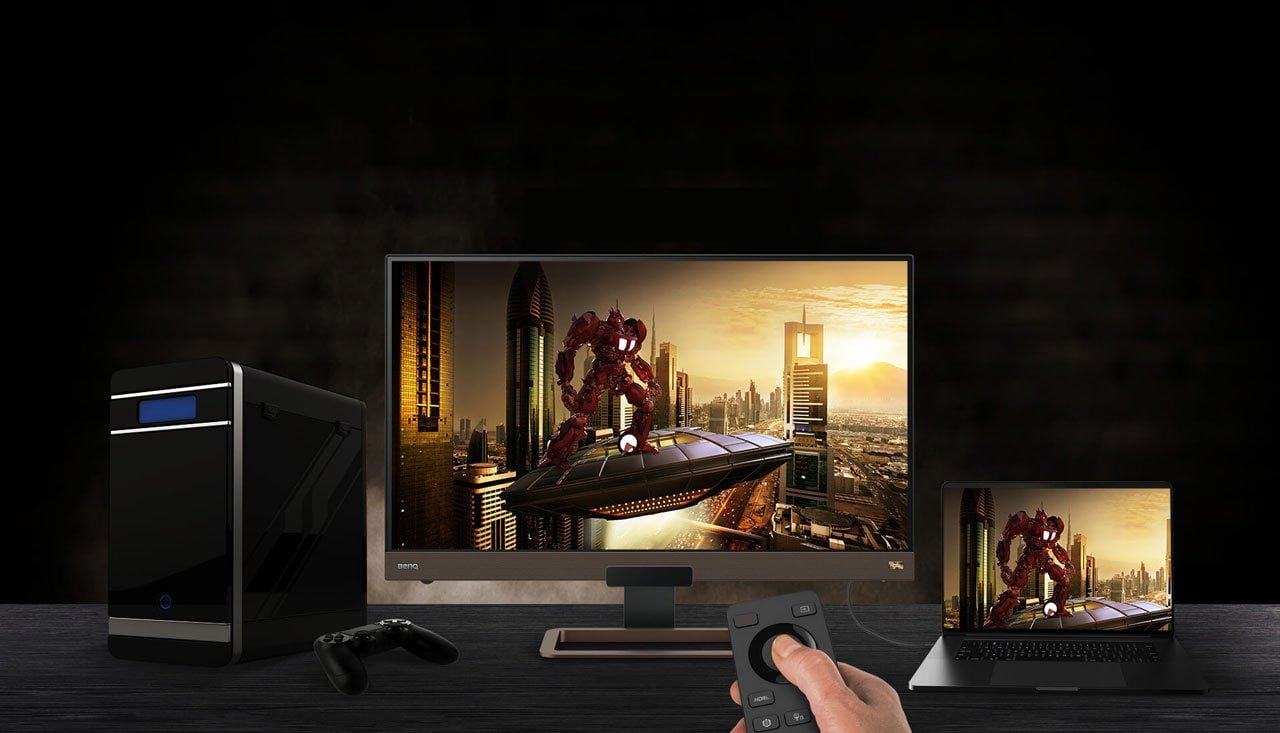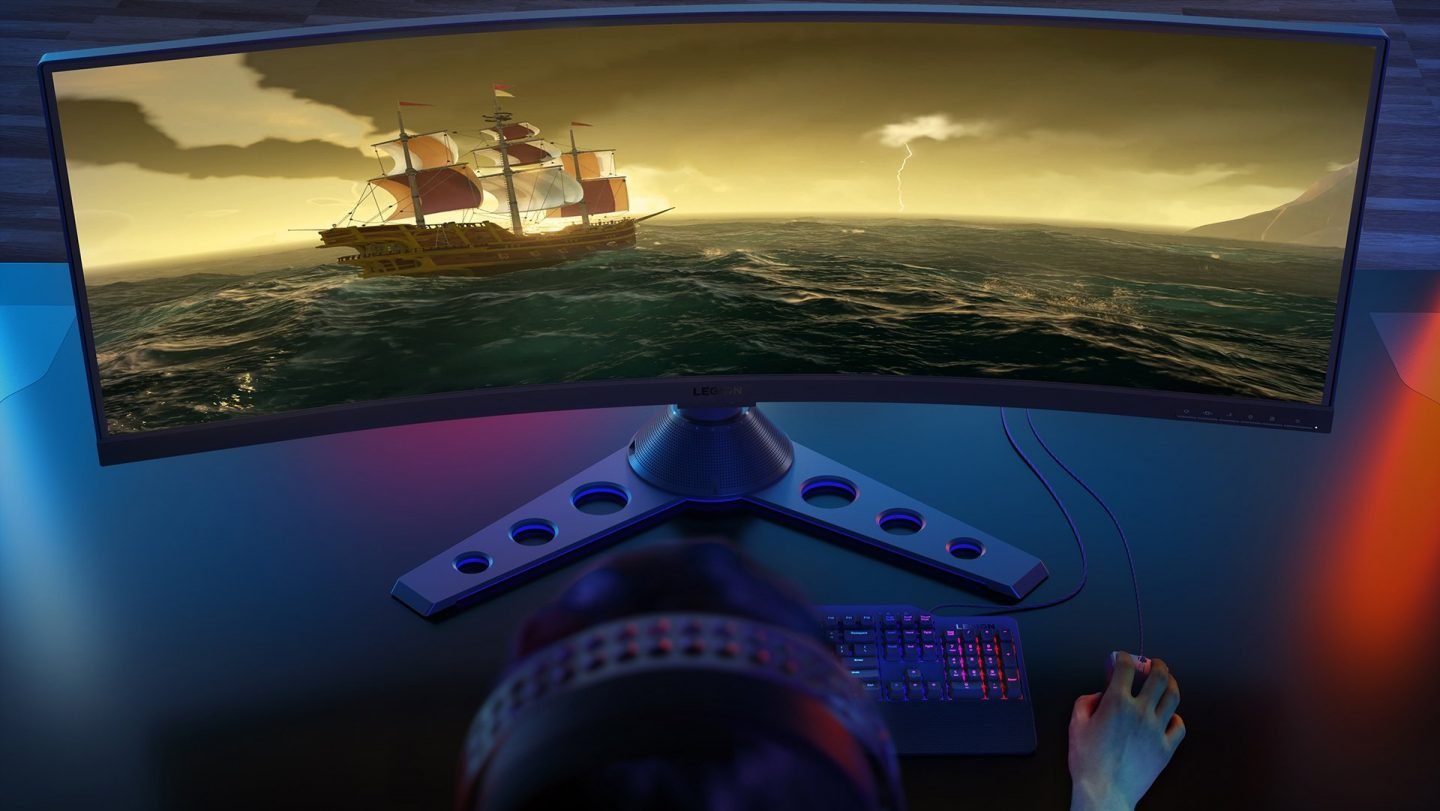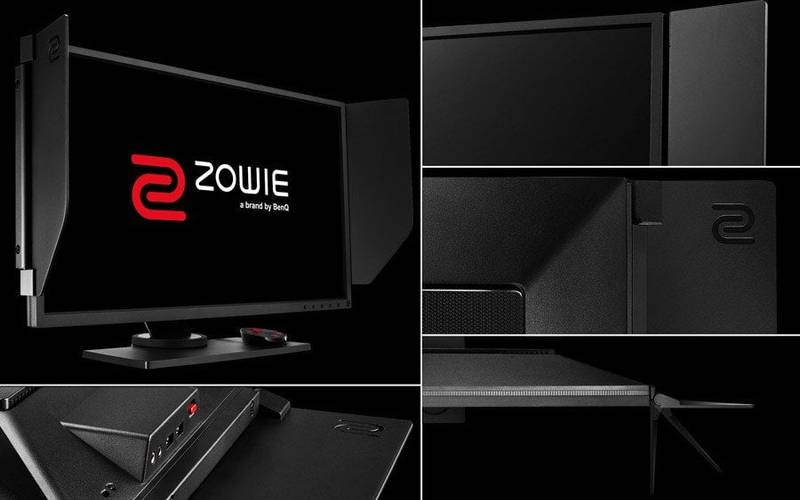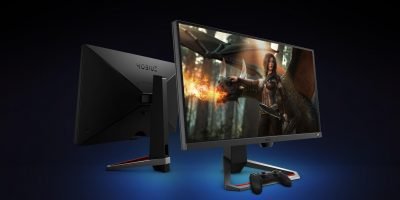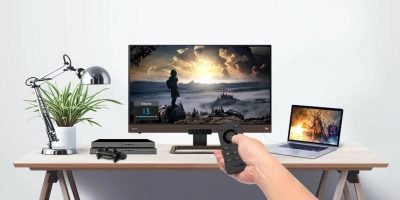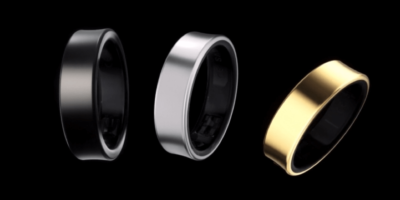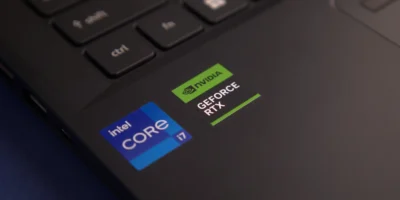The BenQ EX2780Q is one of BenQ’s latest gaming monitors in UAE. We’ve been using the EX2780Q as our primary monitor for over two weeks now. It’s combination of a color-accurate, fast-refresh IPS panel and strong speakers offer a strong entertainment experience.
The BenQ EX2780Q delivers gaming-grade specs with a 144Hz refresh rate, 5ms response time, 1440p resolution, all in a 27inch IPS panel. This gaming monitor supplements these specs with more tech: AMD Freesync technology, HDR, Brightness Intelligence Plus, Black eQualizer, and blue light settings, not to mention all the audio and video presets. It goes above and beyond your typical gaming monitor is with its remote control, and most noteworthy—it’s 2.1-channel speaker design, a surprisingly good speaker system, bolstered by a subwoofer to provide crisp bass. The pairing of two 2W speakers with a 5W subwoofer is surprisingly effective.
It also does well at handling HDR content, and BenQ offers a further enhancement through its own HDRi technology.
| Panel Type | IPS |
| Screen Size, Aspect Ratio | 27 inches |
| Max Resolution & Refresh Rate | 2560 x 1440 @ 144 Hz, FreeSync |
| Native Color Depth & Color Gamut | 10-bit / DCI-P3 |
| Response Time (GTG) | 5ms |
| Brightness | 400 nits |
| Contrast | 1,000:1 |
| Speakers | 2x 2W speakers, 1x 5W subwoofer |
| Ports | 1x USB-C 2x HDMI 2.0 1x DisplayPort 1x 3.5mm headphone jack |
| Power Consumption | 70W |
| Panel Dimensions(WxHxD) | 18.1 x 24.2 x 7.7 inches (459 x 614 x 196mm) |
| Weight | 13.1 pounds (5.9kg) |
Design & Build
The EX2780Q’s frame is simple and handsome, with a matte-black shell and a copper-colored bottom bezel and base. When mounted to its stand, the EX2780Q measures 18.1 by 24.2 by 7.7 inches (HWD) and weighs 5.9 kilograms. The monitor is bezel-free on three sides, while the bottom is 1.3 inches thick to accommodate the grill for the included speaker system. The base is a rectangular ring, which, in addition to supporting the monitor, can serve as an area in which to stash the remote and other small peripherals. The stand provides tilt control, but it lacks swivel, pivot, or height adjustment.
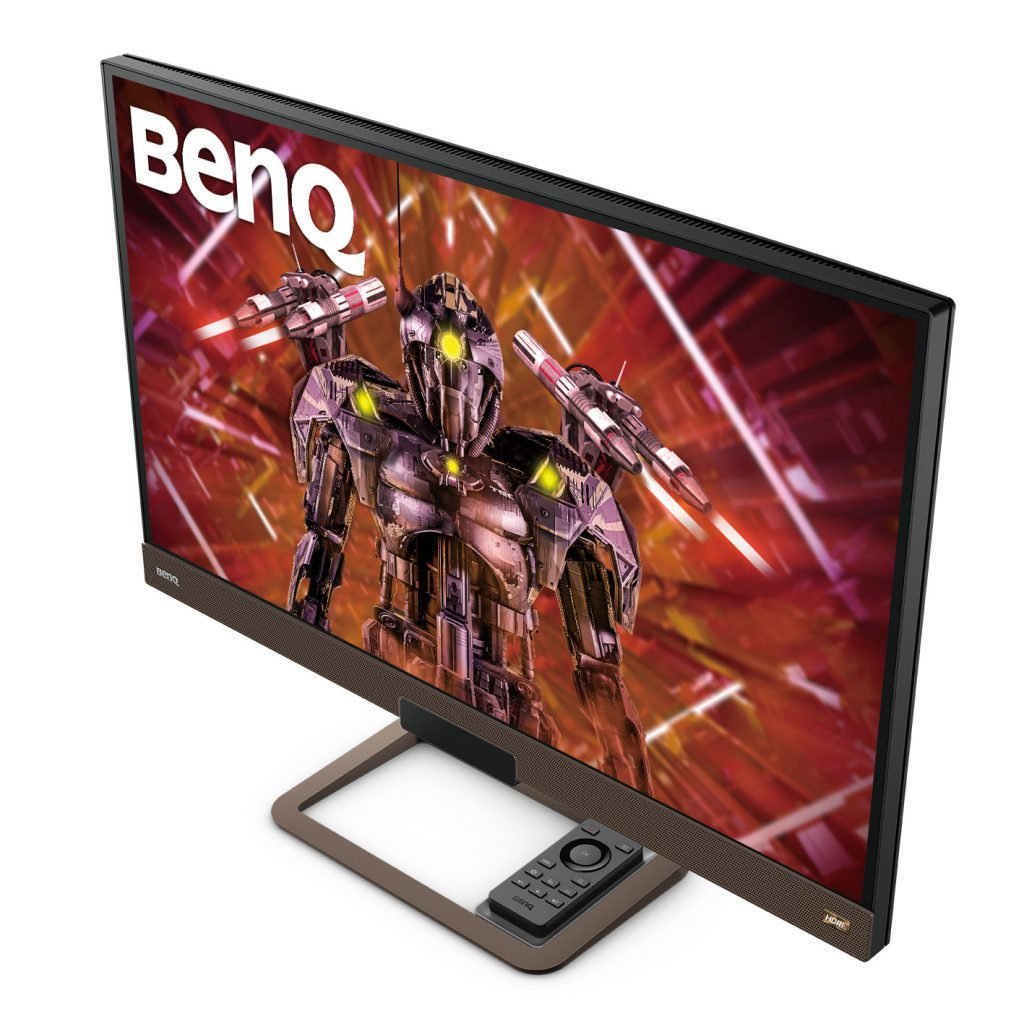
You will still see panel borders when the device is in use, but it’s quite thin so you won’t notice them while gaming. This makes the BenQ EX2780Q ideal for dual or triple setups. Build quality on the BenQ EX2780Q is excellent and it shows in the refinements of the monitor’s aesthetics. Every bit is perfectly molded, so you won’t see gaps or warping on all of the monitor’s parts. We also did not notice any audible issues on the monitor such as electronic humming or creaking from the mechanisms.
Controlling the BenQ EX2780Q’s functionalities is easy thanks to the very capable remote that allows you to manipulate the monitor’s settings from anywhere in your room. There is also a 5-way joystick at the rear for near-field use and a nifty volume wheel which eliminates the need to set the speaker output via your OS.
Display
The BenQ EX2780Q sports a 27-inch IPS panel with a 2560 x 1440 resolution, 144Hz refresh rate, and 5ms response time. The contrast ratio is listed at a typical 1000:1, while the backlight is rated with a 400cd/m2 peak output..
The 27-inch size and 1440p resolution are perfectly matched, so you won’t need to use scaling for text in exchange for the bump in sharpness. Game graphics will look cleaner with straighter edges, thanks to the higher pixel per inch ratio. Some games will already look fantastic even without image improvement technologies such as Anti-Aliasing which is great especially since QHD is quite taxing on most GPUs.
The 27-inch, 10-bit IPS flat panel has a native resolution of 2,560 by 1,440 pixels, known as QHD, at a 16:9 widescreen aspect ratio. Its pixel density of 109 pixels per inch (ppi) is fine for a gaming monitor, but it’s not ideal for tasks such as editing photos.
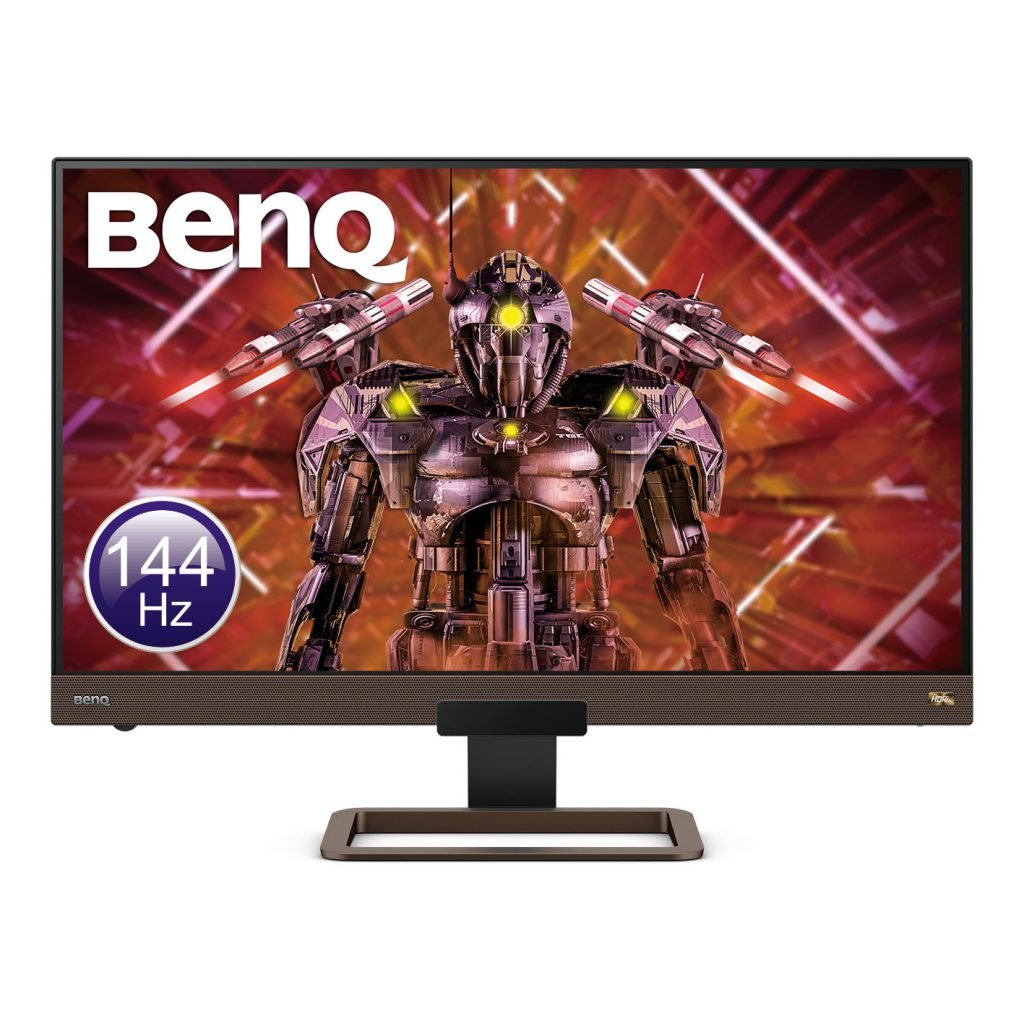
The monitor’s typical brightness is 350 nits, but it’s able to achieve a peak of 400 nits, earning it DisplayHDR400 certification. It also offers BenQ’s dynamic HDRi technology to tune the HDR experience. This has several different presets, with a Cinema HDR, Game HDR and Display HDR option.
One of the highlights of the BenQ EX2780Q is its HRDi function. HRDi brings BenQ’s Brightness Intelligence Plus into the mix which utilizes a front-mounted light sensor to adjust the screen accordingly. This feature automates the utilization of the backlight, so it has mixed results depending on your preferences and media.
Finally, there are some BenQ-exclusive features present here too, and that makes a worthwhile addition to the EX2780Q. They come in the form of the flicker-free technology, low blue light settings, and the Brightness Intelligence Plus (B.I.+). The latter is geared to automatically adapting and augmenting the on-screen picture, brightness and color warmth, depending on what is being displayed but also based on your real-life surroundings.
HDRi
With the EX2780Q, BenQ is using what it calls HDRi technology. Essentially, HDRi is the extended range of colors and contrast HDR offers, mixed with some intelligence BenQ has built into the display to adjust the image based on your ambient lighting. According to BenQ, this results in less eye strain and, ultimately, a clearer picture that tones down overexposed areas of the screen and helps you pick out more detail in shadows. While HDR improves the contrast and dynamic range of a scene, HDRi seeks to further enhance HDR images. It has both hardware and software components.
A sensor on the monitor’s bottom bezel measures ambient light, letting the EX2780Q adjust its screen brightness in response to changing conditions. In addition, HDRi generally brightens dark regions without overexposing bright areas, resulting in a more balanced image. It also automatically tweaks color balance and saturation, depending on the displayed content.
The EX2780Q provides two different HDRi modes: Cinema HDRi, and Gaming HDRi. In testing, we found that generally the HDRi modes (and especially Cinema HDRi) provided better contrast than when the monitor was set to DisplayHDR (unmodified HDR).
There are also several different emulated HDR modes for things like cinema and games, giving you a fair amount of control over how it looks. The emulated HDR certainly didn’t work flawlessly with every bit of content. However, it definitely made a lot of standard definition content much more vivid and engaging to watch. I even found myself leaving it on while working and enjoying the way it adapted to my normal workday.
Input / Output
The I/O on the BenQ EX2780Q doesn’t offer a lot of ports, but it includes sophisticated standards such as two HDMI 2.0 ports, one DisplayPort input, a USB-C port, and an audio-out jack. The USB-C port supports data transfer and video input, as well as power delivery of up to 60 watts, which is enough to quickly charge a laptop even when displaying content over the connection.
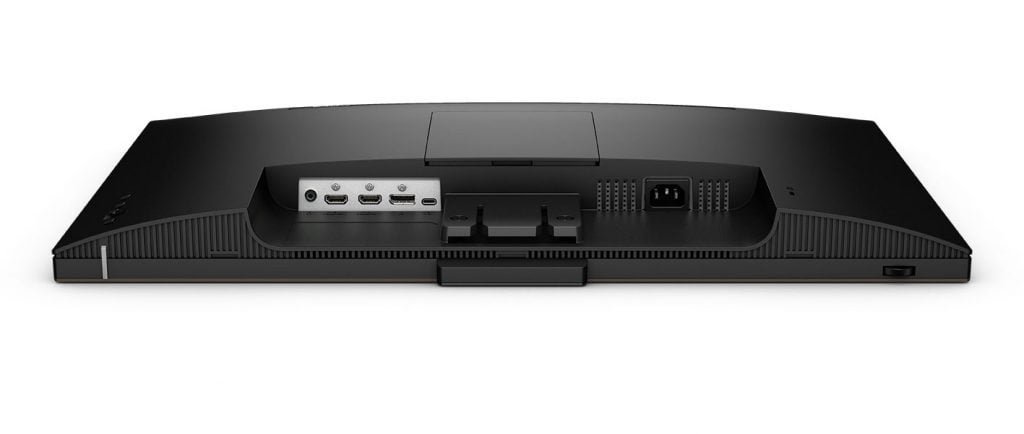
Controlling the BenQ EX2780Q’s functionalities is easy thanks to three helpful features included in the design. The device includes a very capable remote that allows you to manipulate the monitor’s settings from anywhere in your room. There is also a 5-way joystick at the rear for near-field use and a nifty volume wheel which eliminates the need to set the speaker output via your OS.
Onscreen Display
You can control the onscreen display (OSD) via a miniature joystick controller on the back of the monitor, mounted near its lower right corner. Its menus are easier to navigate with the joystick than with the button-based control systems found in many monitors. If the joystick isn’t convenient enough, you can also browse through the EX2780Q’s OSD with the included handheld remote. There is also a volume-control wheel on the bottom of the monitor, near the left-hand edge.
The OSD offers seven main-menu choices: Input, Picture, Color, Audio, Eye Care, Custom Key, and System. From Input, you can switch among HDMI, DisplayPort, and USB-C inputs. The Picture menu lets you control brightness, contrast, sharpness, and the like. The Color menu lets you choose among 11 color modes, including Standard, Low Blue Light, three gaming modes, two Custom modes, and M-book (a mode for the MacBook. You can also switch between HDR modes.
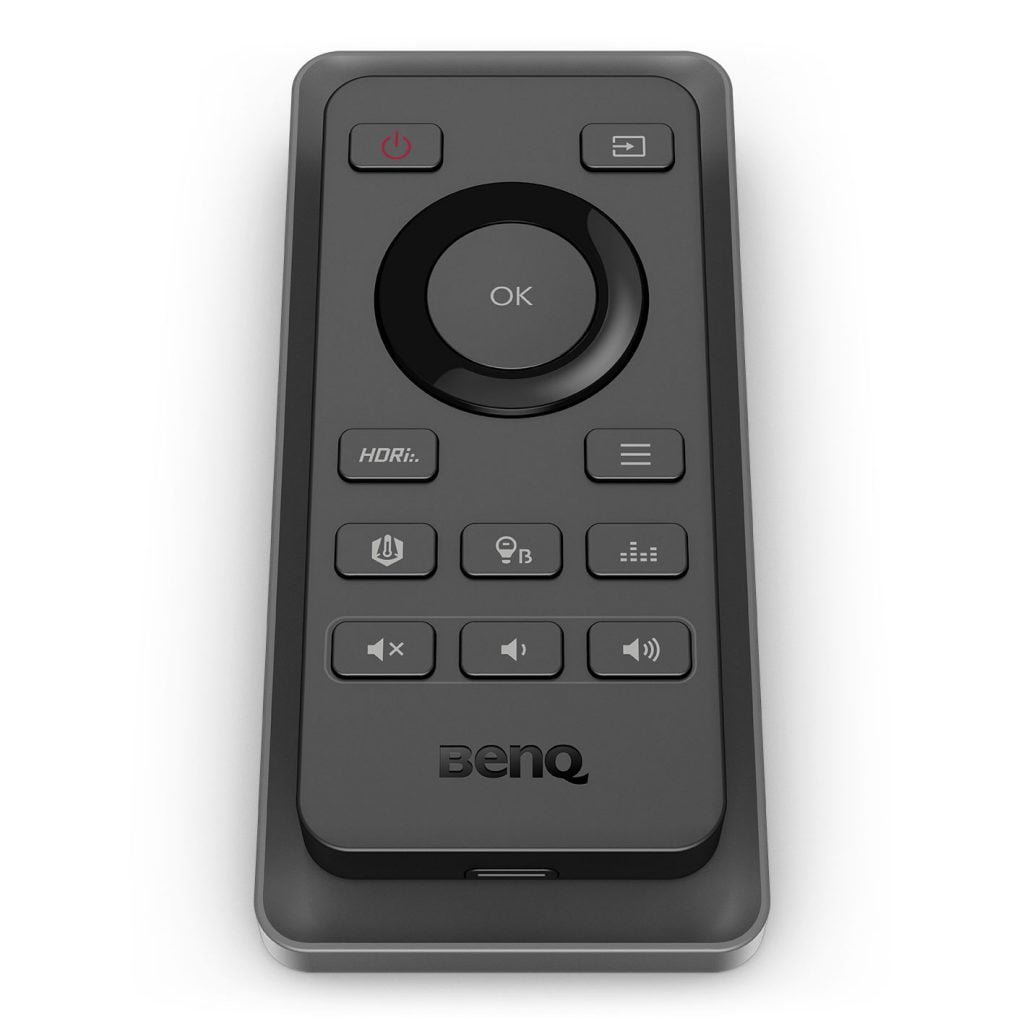
From the Audio menu, you not only can control the volume or mute the sound, but you can also switch through five audio modes: Live/Pop, Cinema, Dialogue/Vocal, Game, and Rock/Party. Eye Care offers access to the Low Blue Light setting (again) and several similar tweaks. Custom Key lets you set up two customizable color modes, and last up is the System menu, on which you control FreeSync, USB-C configuration, OSD settings (such as language), and the like.
Audio
The EX2780Q combines a pair of 2-watt speakers with a 5-watt subwoofer. These are built upon BenQ’s treVolo technology that includes five-sound indicators as well as three pre-tuned EQ settings that you can select from. And from a decent bass end to a crisp treble peak, they do a pretty good job of offering an immersive authentic audio experience – considering they are just built-in, on-board monitor speakers.
Music actually sounded robust, and game audio was immersive without requiring me to plug my headset on. There are plenty of audio modes to choose from as well, if you need to tweak the sound for gaming, movies, or music. At max volume, the monitor’s 2.1 channel speaker in the front, along and 5W subwoofer running along the back, filled a medium-sized conference room easily. The sound overall wasn’t overwhelmingly loud, but maintained its max volume without distortion.
Audiophiles may still want to add external speakers, but for most consumers, the built-in speaker system should more than suffice for casual listening.
Gaming Performance
The EX2780Q employs AMD FreeSync adaptive-sync technology, and it supports refresh rates of up to 144Hz. It should also work with G-Sync as long as you use the DisplayPort slot. The monitor isn’t certified so the latter isn’t guaranteed, but it can be activated manually via Nvidia’s Control Panel. Input lag sits at a little over 4ms at 144Hz, so you won’t see any delays or “de-synced” instances during gameplay.
The monitor did well in handling gameplay in our benchmark runs with the titles Witcher 3, Shadow of the Tomb Raider, and Far Cry 5, showing a minimum of artifacts. Among Game HDRi, Cinema HDRi, DisplayHDR, and SDR modes, the Cinema HDRi showed the best contrast.
The Verdict
The EX2780Q quickly demonstrates itself as an excellent gaming monitor. The colors are absolutely wonderful and a genuine joy with the monitor’s HDR being good enough to be an experience-enhancer. The contrasts are lovely and the tone of each color is rich. While boasting gaming-friendly specs, like 144 Hz and FreeSync, it also comes with all of BenQ’s eye protection technologies, including one for helping people with difficulties seeing red and green, a remote for easy adjustments, and a touch of style in its speakers.
The BenQ EX2780Q has a great sound system and handles HDR (both DisplayHDR and BenQ’s HDRi enhancement). With its ability to handle games, video, and photos while providing superior audio, the BenQ EX2780Q is a definite all-around entertainment monitor with a focus on gaming.
Finally, there’s the remote. It became a delightful little addition to the experience of using the EX2780Q. Instead of fiddling with buttons on the rear of the monitor, I could much more quickly switch between HDR modes or adjust the volume with the remote.
While its HDRi feature seems to have its pros and cons, there’s no doubt that HDR content looked beautiful on this IPS panel with wide color gamut coverage. Additionally, cable management and speakers that should satisfy mainstream gamers enhance the value and keep your desk clear.
Pricing and availability
The BenQ EX2780Q monitor is available starting at AED 1,861
